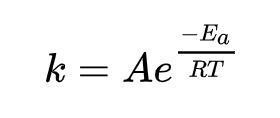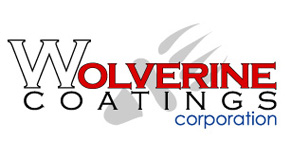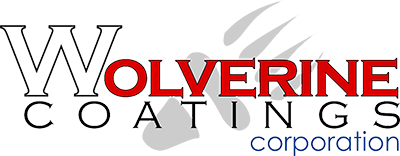Arrhenius Equation:
The Arrhenius equation is a formula for the temperature dependence of reaction rates. This equation has a vast and important application in determining rate of chemical reactions and for calculation of energy of activation. It can be used to model the temperature variation of diffusion coefficients, population of crystal vacancies, creep rates, and many other thermally-induced processes/reactions. A historically useful generalization supported by the Arrhenius Equation is that, for many common chemical reactions at room temperature, the reaction rate doubles for every 10 degree Celsius increase in temperature.
Arrhenius’ equation gives the dependence of the rate constant of a chemical reaction on the absolute temperature, a pre-exponential factor and other constants of the reaction.

K is the Rate Constant
T is the Absolute Temperature (in kelvin)
A is the Pre-Exponential Factor, a constant for each chemical reaction. According to Collision Theory, A is the frequency of collisions in the correct orientation
Ea is the Activation Energy for the reaction (in the same units as R*T)
R is the Universal Gas Constant
Curing Agents /
Hardeners:
The purpose of the epoxy curing agent or hardener is to join or crosslink epoxy resin
reactive sites (functional groups) to form a fully reacted or cured polymer. Just as
there are many epoxy resins, there are a variety of curing agents that are commonly
used that contribute to the characteristics of the final products. Amines are the most
widely used curing agents for epoxy resins systems. The amine curing agents fall into
several chemical families that include the aliphatic amines, cycloaliphatic amines, and
aromatic amines. Anhydrides are another class of curing agents for epoxy resin systems.
Some effects of common curing agents are described below. The aliphatic amines,
cycloaliphatic amines and anhydride curing agents may cause irritation or damage to the
skin, eyes, and lungs. Certain aliphatic and cycloaliphatic amines are skin sensitizers.
Solid anhydride curing agents may cause sensitization in workers exposed to the curing
agent dust. The aromatic amines are not strong irritants, but several are skin sensitizers.
Certain aromatic amines may absorb through the skin and cause damage to organs such
as the liver and interfere with the blood’s ability to carry oxygen. Certain aromatic amine
curing agents are known to cause cancer in laboratory animals.
De-Fatting:
Action in which solvents permeate the skin and cause the natural body oils and fat layer
in the skin surface to be removed, causing dry skin leading to increased skin cracking
and drying, allowing for increased potential for skin reactions.
Dermatitis:
There are two types, irritant and allergic.
Dermatitis (Allergic): The allergic reaction involves an overreaction of the body’s
immune system, which, once triggered, tends to be a long term or permanent effect
(see Sensitizations). The symptoms only appear when there is exposure to the trigger
chemical and once exposure is removed, the symptoms recede as the body recovers.
The onset of symptoms is usually very quick – seconds or minutes. The symptoms
may be apparent over the whole body, which can manifest in a similar way to irritant
reactions. It is not possible to determine in advance why a particular person may be
affected. It is an individual intolerance to a particular material.
Dermatitis (Irritant): The irritant reaction occurs where the chemical damages the skin
directly at the point of contact. The damage may not be immediately apparent, but if the
exposure is repeated, it may result in an accumulation of damage until the skin can no
longer tolerate any further exposure. The result is that the skin can become inflamed,
itchy and often a red rash with cracking and blistering appears. If the exposure is minor,
the skin will heal when the contact is removed. However, extensive contact may cause
more severe damage.
Fibers and Reinforcements:
A range of materials, including carbon, aramid (Kevlar™ or Twaron™) and glass fiber, is
used in conjunction with resins and hardeners. If good hygiene practices are followed,
the health risk from using these materials is low. There are various factors to take into
consideration. Carbon fiber is electrically conductive and free-floating fiber in the air can
be drawn into electrical equipment that has the potential to cause short circuits. All of
the fibers can be an irritant to the lungs, skin and eyes and suitable protection should be
worn when using and particularly when cutting these materials.
Filler Powders:
These tend to be very light and are easily carried into the air. They are primarily irritating
by inhalation and in contact with the skin and eyes. Care should be taken when mixing
these powders into resin systems and good hygiene practices observed.
Fillers:
Added to epoxy resins to enhance the properties of the cured resin system. The
properties most commonly enhanced with fillers include: thermal, mechanical, electrical,
chemical resistance, and flame resistance. Examples of fillers are fiberglass, silica,
calcium carbonate, powdered metals, and pigments. Fillers added to epoxy resin
formulations present a potential inhalation and dermal contact hazard. They can cause
mechanical damage to the skin, which may aggravate the irritant effects of the epoxy
resin system. Since fillers are generally handled in the liquid matrix of the epoxy resin
system, their potential to present an inhalation hazard is low. However, inhalation
exposure to fillers can occur when they are handled in the dry state or when machining
or grinding cured epoxy products. Inhalation exposure to fillers such as crystalline silica
or fiberglass may result in delayed lung injury.
Liquid Resins:
Liquid resins are mild to moderate irritants to the skin, eyes and mucous membranes.
The irritant potential is increased by their “sticky” nature, which tends to lead to
prolonged skin contact. These resins are generally mild to moderate dermal (skin)
sensitizers in susceptible individuals.
Modified Liquid:
Resins are resins modified by the addition of reactive diluents (see page 3) or solvents
(see page 2). Both chemicals and water are used as solvents. When water is used, the
resins are referred to as “waterborne resins.” These resins should be handled with the
same precautions as those in chemical solvents. They are mild to moderate skin irritants.
These low molecular weight resins and the reactive diluents are moderate to strong
sensitizers. Their sensitizing potential tends to increase with decreasing molecular
weight. Epoxy components with significant volatility could cause irritation to skin,
eyes and respiratory tract, but inhalation is normally not a hazard except under certain
conditions of use, i.e., heating, spraying, or applications with large surface areas. Certain
modified resins, such as cycloaliphatic epoxy resins have been shown to cause skin
cancer in laboratory animals.
Route of Exposure:
The path by which a material enters the body, most commonly the mouth (ingestion),
skin (dermal absorption) or respiratory tract (inhalation).
Sensitizations:
If a person exhibits a reaction to a particular material but only after a period of repeated
contact it is called sensitization. Once the allergic reaction has been established then
even a low level of brief repeat contact will trigger the reaction. The symptoms will
usually appear as a rash of varying coverage, intensity and discomfort. The period
between first contact and subsequent development of sensitizations, causing the
rash to appear, can vary from days to years. This is a highly individual problem. Some
workers will be able to handle so-called ‘sanitizers’ for years with no effect. Some will
react almost immediately and others may only show the reaction after having handled
the material for many weeks or months. Sensitizations can occur through skin and
respiratory contact.
Sensitizer:
A substance that may cause an allergic reaction in some individuals after repeated
exposure. Epoxy resin system components may be skin sensitizers, pulmonary
sensitizers or both
Solid Resins:
Solid resins are not readily absorbed through the skin and present a low risk of skin
irritation. Direct contact with solutions of these resins can cause mild to moderate
irritation of the skin and the eyes, principally because the solvents “de-fat” the skin.
When crushed to a fine powder, the materials should be considered an irritant dust;
inhalation and skin contact should be avoided. Solid resins are generally low to mild
sensitizers.
Solvents:
Solvents may be present in the epoxy resin system formulations or may be used as
a cleaning agent for equipment. Examples of solvents typically used in epoxy resin
systems are acetone, methyl ethyl ketone (MEK), toluene, xylene, glycol ethers, and
alcohols. Solvents commonly used in epoxy resin applications present a flammability
hazard. These solvents present other special health hazards. Contact with solvents will
cause “de-fatting” and drying of the skin, which may result in an increased chance of
skin irritation. Some solvents are absorbed directly through the skin and absorption
may be enhanced if the skin is abraded or irritated. They also have the ability to dissolve
other epoxy resin system chemicals and carry them through the skin. The inhalation of
solvent vapors or mists may cause respiratory irritation and depression of the central
nervous system. This may result in dizziness and sleepiness, lack of coordination, loss of
equilibrium, unconsciousness, and even death, if severe overexposure occurs.
Solvents and Solvent Based Systems:
Some epoxy products are solvent based and working with these can present particular
hazards due to this solvent content. Inhalation should be avoided as the vapors can lead
to nausea, headaches, and in serious cases loss of consciousness. Adequate ventilation
must be ensured and work in confined spaces limited as solvent vapors are harmful
and can be flammable above certain concentrations. Skin contact should be avoided
as solvents can help induce dermatitis by removing the natural oils that are the skin’s
protection. The washing of hands in solvents is not recommended and is a major cause
of skin problems.
